ISSN ONLINE(2319-8753)PRINT(2347-6710)
ISSN ONLINE(2319-8753)PRINT(2347-6710)
| Tawfeg A. Elhisadi Ph.D, Emtenan Ali Esrafel BSc , and Shereen Salah Al-den Ben Hamadi BSc. Faculty of Medical Technology, department of public health. Derna- Libya |
| Related article at Pubmed, Scholar Google |
Visit for more related articles at International Journal of Innovative Research in Science, Engineering and Technology
The objective of the study were to Identify the food, service, and patient variables that contribute to food service dissatisfaction utilizing a validated patient survey, and to collect information about types, methods and arrangements of sending meals to hospital wards. Methodology: The diet survey was conducted used a questionnaire and interview with hospitalized patients, this study was used 24 hours recall including all foods and beverage consumed during previous 24 hours. A total of 30 hospitalized patients selected randomly in this study, aged 22 to 79 years old, (average age 57.6 years ±10.3 and 43.5 years ±13.6 and for males and females respectively). 14 males and 16 female (Only hospitalized patients were included in this study). Results: This study revealed that the high dietary intake was bread ,salad, juices, red meat , soup, milk full cream, and fruits (93.3), (83.3%), (60%), (53.3%), (36.7%) and (40%), respectively. Wahda hospital's diet are characterized by low intake of fresh fruits, fish and dietary fibre, and high intake of fat-rich foods such as frying meat, minced meat, cheese, and sweet foods mixed with butter, and full cream milk. Conclusion: This study revealed that insufficient micronutrients intake such as iron can lead to iron-deficiency (anaemia). This study concluded that about (46.7% ) of hospitalized patients ate foods that came from outside hospital without monitor.
Keywords |
| diet, hospitalized patients, 24 hours recall. |
INTRODUCTION |
| Hospital food and nutrition services play an important role in patient recovery and well-being. Hospital catering patient care it is important to monitoring and to record the food and beverage intake of patients with nutritional problems. Patients who require support with eating and drinking are clearly identified, The provision of food, fluids and nutritional care in hospital is a multifaceted area of service and is the responsibility of many members of the hospital team. but not all patients get the help they need at mealtimes during our ward visits; however of those patients responding to our survey who needed help to get comfortable before eating . Nutrition screening of hospital patients is widely supported in evidence based guidelines because poor nutritional status has a negative impact, increasing patients’ morbidity, mortality and length of hospital stay. A therapeutic diet should only be given to the patient for whom it has been specifically prescribed. It should never be used for anyone else (1). Planning a menu effectively requires the collection of a wide range of information and input from numerous groups within a hospital(2). Food /fluid which has had its nutrients modified to meet the nutritional need of a person , and which forms part of their medical treatment to prevent symptoms or improve nutritional status (3) . Many patients who are ill in hospitals or other care settings and have poor appetites or an impaired ability to eat are at risk of developing under-nutrition (4). Older people are more likely to be undernourished when admitted to hospital and remain undernourished during their hospital stay .they also have longer periods of hospital stay. The majority of patients depend on ordinary hospital food to improve or maintain their nutrition state in order to optimize their recovery from illness (5). dietary restrictions to reduce the risk of infection need to be balanced against ensuring patients' nutrition needs can be met . this will be important to ensure that patients can benefit from the treatment they are receiving (6). Deficiency in iron, iodine, vitamin A and zinc are still major public health problems in developing countries (7). |
II. MATERIAL AND METHODS |
| A total of 30 hospitalized patients included of 14 males and 16 female, in Wahda hospital in Derna city aged 22 to 79 years old, (average age 57.6 years ±10.3 and 43.5 years ±13.6 for males and females respectively), were selected randomly for evaluation food intake through the 24 hours recall as showed in table 1. The diet survey was conducted using questionnaire, each participant recorded everything they ate and drank during previous 24 hours, and interview face to face with patients. Energy, macro and micronutrients intakes were determined for meals consumed. Only hospitalized patients were included in this study. |
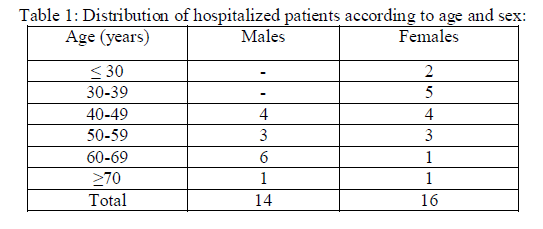 |
III. STATISTICAL ANALYSIS |
| The Statistical Package of Social Science (SPSS) version 13.0 under Microsoft of Windows 7 professional was used for data analysis and descriptive statistics analysis (mean, median, and standard deviation) were calculated. |
IV. DISCUSION |
| The dietary intake data for this study are taken from just a single, 24-h dietary recall interview that covered a one day. A patient intake of specific nutrients may vary considerably from one day to the next being high one day and low another and still constitute an adequate intake over a period of time. The data utilized for this study were collected by visiting 30 hospitalized patients . The diseases that was present in the patients included in the study such as hypertension (43.3%) is the most rate in the diseases thus diabetic mullets (36.7%) and heart diseases (20%) as showed in table 2 and figure 1. |
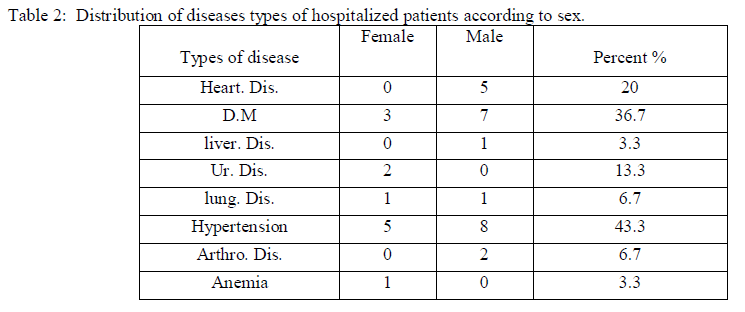 |
 |
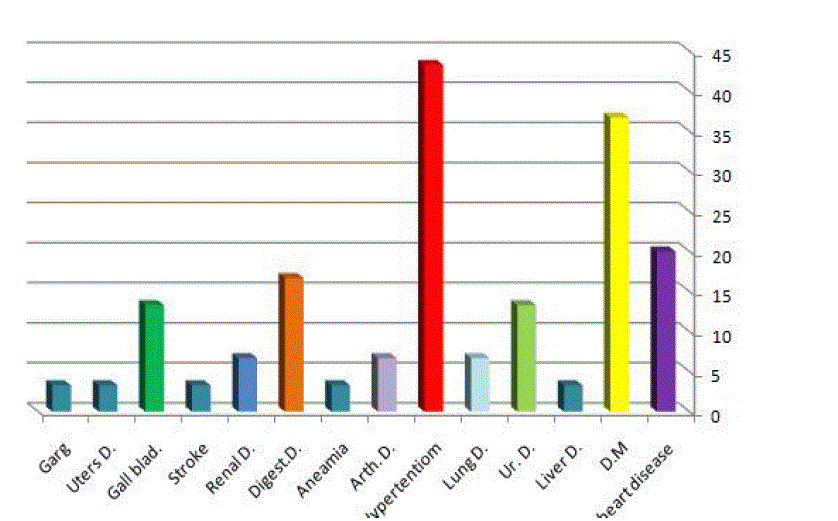 |
| Figure 1: Prevelance of diseases among hospitalized patients. |
| A varied and balance of diet is essential to good health. Poor nutrition contributes to at least 30 percent of death from Coronary Heart Disease (CHD) (8). This study revealed that the high dietary intake was bread ,salad, juices, red meat , soup, milk full cream, and fruits (93.3), (83.3%), (60%), (53.3%), (36.7%) and (40%), respectively. High dietary intake of bread and low dietary intake of fruits revealed to increase energy intake imbalance and unhealthy diet, unfortunately, hospitalized patient’s diet was low in micronutrients (important vitamins which found in fruits). This study revealed that insufficient micronutrients intake such as iron can lead to iron-deficiency (anaemia). High consumption of tea, can inhibits absorption of iron and is widely consumed in this area. To help absorb the iron more effectively, it is recommended to combine iron-containing foods with vitamins C rich foods such as citrus fruits as showed in table 3 and figure 2. |
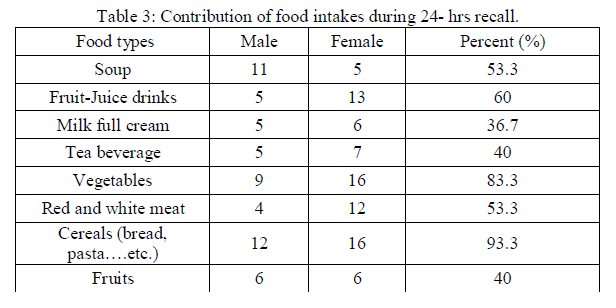 |
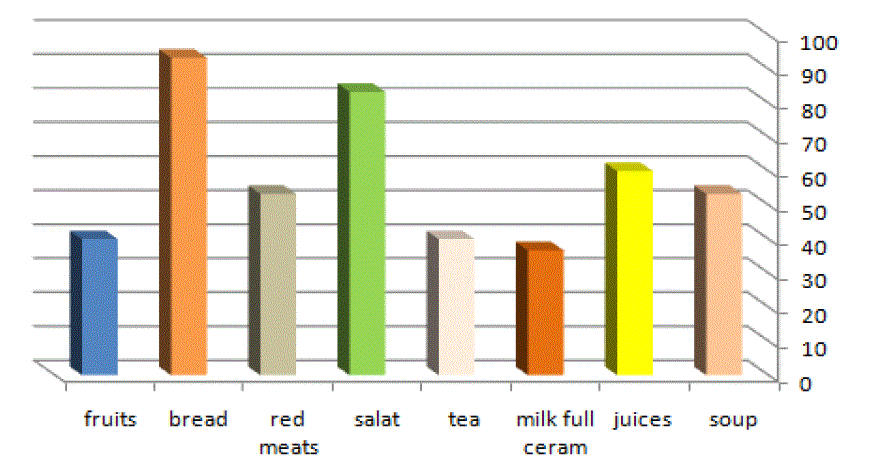 |
| This study concluded that about (46.7% ) of hospitalized patients ate from outside foods that came from outside hospital without monitor, Low fibre intake and increased fat consumption may come from eating snacks, deep fried food, fat rich foods which came from outside may increase risk of disease, from other side about (53.3%) of hospitalized patients ate according to diet prepared inside hospital kitchen without specification food to disease quality. This study concluded that about (46.7% ) of hospitalized patients ate from outside foods that came from outside hospital without monitor, Low fibre intake and increased fat consumption may come from eating snacks, deep fried food, fat rich foods which came from outside may increase risk of disease, from other side about (53.3%) of hospitalized patients ate according to diet prepared inside hospital kitchen without specification food to disease quality. According to the results, Wahda hospital's diet are characterized by low intake of fresh fruits, fish and dietary fiber, and high intake of fat-rich foods such as frying meat, minced meat, cheese, and sweet foods mixed with butter, and full cream milk, it is probable that played an important role in increasing Coronary heart disease (CHD), stroke, hypertension and certain types of cancer. Wahda hospital's diet didn't depends on the type of disease. |
VI. RECOMMENDATION |
| A reduction in the consumption of fat (especially saturated fat) was highly recommended. We suggest that nutritional should encompass both hospital and family with educational and practical strategies to diminish this serious problem. This study recommended the importance of nutrition education to hospital administration on hygienic food preparation and nutrition. The healthy balanced diet is recommended for the general population but it is also recommended for the dietary management of a number of medical condition and in such situations it can be interpreted as a therapeutic diet. The patients identified at low risk of nutritional problems on admission should be weighed and re-screened weekly to ensure that their nutritional status has not changed . |
ACKNOWLEDGEMENTS |
| The authors wish to express their sincere to all participants in this study. |
References |
|